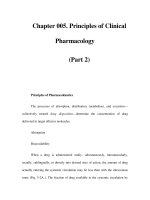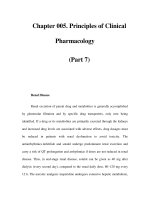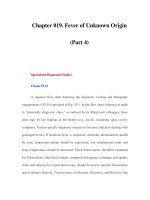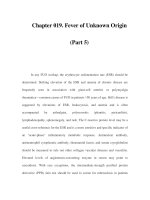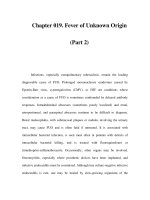Chapter 019. Fever of Unknown Origin (Part 4) ppt
Bạn đang xem bản rút gọn của tài liệu. Xem và tải ngay bản đầy đủ của tài liệu tại đây (423.17 KB, 5 trang )
Chapter 019. Fever of Unknown Origin
(Part 4)
Specialized Diagnostic Studies
Classic FUO
A stepwise flow chart depicting the diagnostic workup and therapeutic
management of FUO is provided in Fig. 19-1. In this flow chart, reference is made
to "potentially diagnostic clues," as outlined by de Kleijn and colleagues; these
clues may be key findings in the history (e.g., travel), localizing signs, or key
symptoms. Certain specific diagnostic maneuvers become critical in dealing with
prolonged fevers. If factitious fever is suspected, electronic thermometers should
be used, temperature-taking should be supervised, and simultaneous urine and
body temperatures should be measured. Thick blood smears should be examined
for Plasmodium; thin blood smears, prepared with proper technique and quality
stains and subjected to expert microscopy, should be used to speciate Plasmodium
and to identify Babesia, Trypanosoma, Leishmania, Rickettsia, and Borrelia. Any
tissue removed during prior relevant surgery should be reexamined; slides should
be requested, and, if need be, paraffin blocks of fixed pathologic material should
be reexamined and additional special studies performed. Relevant x-rays should be
reexamined; reviewing of prior radiologic reports may be insufficient. Serum
should be set aside in the laboratory as soon as possible and retained for future
examination for rising antibody titers.
Figure 19-1
Approach to the patient with classic FUO.
a
"Potentially diagnostic
clues," as outlined by de Kleijn and colleagues (1997, Part II), may be key
findings in the history, localizing signs, or key symptoms. ANA, antinuclear
antibody; CBC, complete blood count; CMV, cytomegalovirus; CRP, C-reactive
protein; CT, computed tomography; Diff, differential; EBV, Epstein-Barr virus;
ESR, erythrocyte sedimentation rate; FDG, fluorodeoxyglucose F18; NSAIDs,
nonsteroidal anti-inflammatory drugs; PET, positron emission tomography; PMN,
polymorphonuclear leukocyte; PPD, purified protein derivative; RF, rheumatoid
factor; SPEP, serum protein electrophoresis; TB, tuberculosis; TIBC, total iron-
binding capacity; VDRL, Venereal Disease Research Laboratory test.
b
Needle
biopsy of liver as well as any other tissue indicated by "potentially diagnostic
clues."
c
Invasive testing could involve laparoscopy.
d
Empirical therapy is a last
resort, given the good prognosis of most patients with FUO persisting without a
diagnosis.
Febrile agglutinins is a vague term that in most laboratories refers to
serologic studies for salmonellosis, brucellosis, and rickettsial diseases. These
studies are seldom useful, having low sensitivity and variable specificity. Multiple
blood samples (no fewer than three and rarely more than six, including samples for
anaerobic culture) should be cultured in the laboratory for at least 2 weeks to
ensure that any HACEK group organisms that may be present have ample time to
grow (Chap. 140). Lysis-centrifugation blood culture techniques should be
employed in cases where prior antimicrobial therapy or fungal or atypical
mycobacterial infection is suspected. Blood culture media should be supplemented
with L-cysteine or pyridoxal to assist in the isolation of nutritionally variant
streptococci. It should be noted that sequential cultures positive for multiple
organisms may reflect self-injection of contaminated substances. Urine cultures,
including cultures for mycobacteria, fungi, and CMV, are indicated. In the setting
of recurrent fevers with lymphocytic meningitis (Mollaret's meningitis),
cerebrospinal fluid can be tested for herpesvirus, with use of the polymerase chain
reaction (PCR) to amplify and detect viral nucleic acid (Chap. 172). A recent
report described a highly multiplexed oligonucleotide microarray using PCR
amplification and containing probes for all recognized vertebrate virus species and
for 135 bacterial, 73 fungal, and 63 parasitic genera and species. The eventual
clinical validation of such microarrays will further diminish rates of undiagnosed
FUO of infectious etiology.
